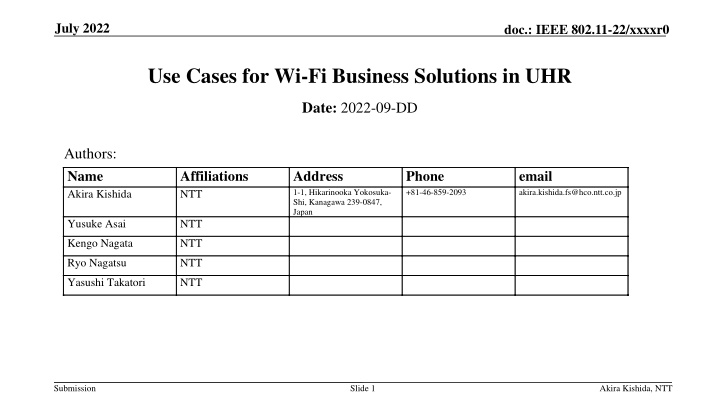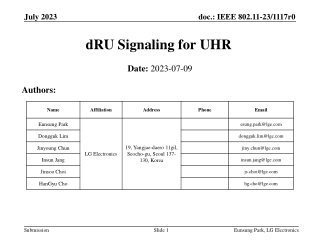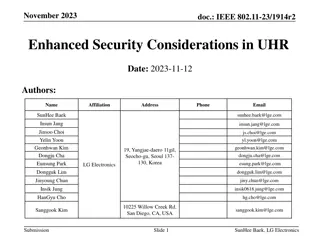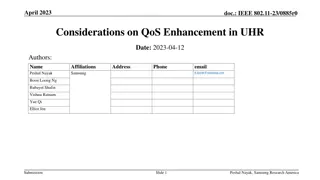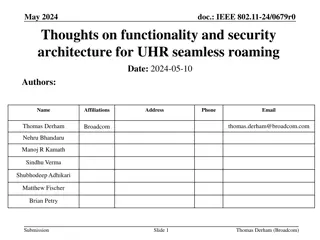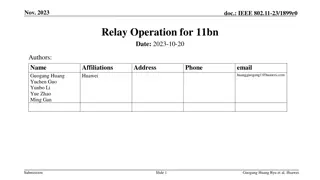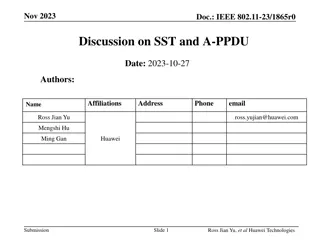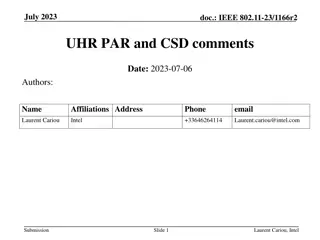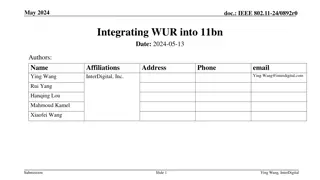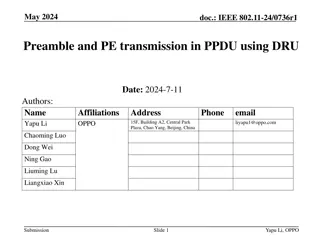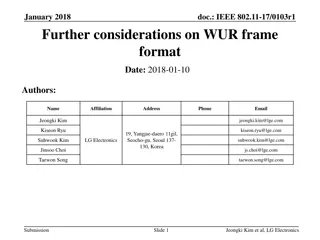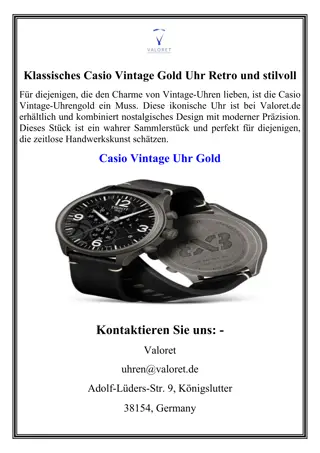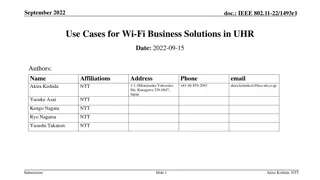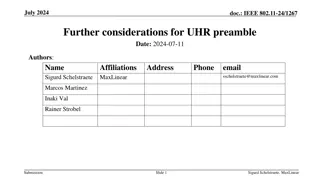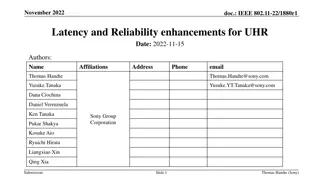Use Cases for Wi-Fi Business Solutions in UHR
This document discusses various use cases for Wi-Fi business solutions focusing on high reliability, with examples categorized by the level of impact if Wi-Fi fails to operate reliably. It emphasizes the importance of Wi-Fi in enhancing network services' reliability and promoting essential access in different industries.
Download Presentation

Please find below an Image/Link to download the presentation.
The content on the website is provided AS IS for your information and personal use only. It may not be sold, licensed, or shared on other websites without obtaining consent from the author.If you encounter any issues during the download, it is possible that the publisher has removed the file from their server.
You are allowed to download the files provided on this website for personal or commercial use, subject to the condition that they are used lawfully. All files are the property of their respective owners.
The content on the website is provided AS IS for your information and personal use only. It may not be sold, licensed, or shared on other websites without obtaining consent from the author.
E N D
Presentation Transcript
July 2022 doc.: IEEE 802.11-22/xxxxr0 Use Cases for Wi-Fi Business Solutions in UHR Date: 2022-09-DD Authors: Name Akira Kishida Affiliations NTT Address 1-1, Hikarinooka Yokosuka- Shi, Kanagawa 239-0847, Japan Phone +81-46-859-2093 email akira.kishida.fs@hco.ntt.co.jp Yusuke Asai NTT Kengo Nagata NTT Ryo Nagatsu NTT Yasushi Takatori NTT Submission Slide 1 Akira Kishida, NTT
July 2022 doc.: IEEE 802.11-22/xxxxr0 Introduction This contribution introduces some use cases for Wi-Fi business solutions that require high reliability. These use cases will expand the Wi-Fi market in addition to existing use cases for customer services, such as providing internet services at homes, offices, and stations. UHR SG/TG will enhance those use cases by raising the reliability of Wi-Fi, which can promote Wi-Fi as essential access to network services. Submission Slide 2 Akira Kishida, NTT
July 2022 doc.: IEEE 802.11-22/xxxxr0 Needs for Wi-Fi business solutions Wi-Fi will be more important not only for customer services, such as providing internet services but also for business solutions [1]. Though mobile access has been utilized for network services with mission- critical applications previously, Wi-Fi could be used for these network services as Wi-Fi business solutions by enhancing the reliability of Wi-Fi. To realize the fundamental digital formation (DX) of industry, it is necessary not only to provide best-effort communication but also to provide reliable connections in all industries via Wi-Fi. The motion of the foundation of UHR SG [2] aims to improve WLAN's reliability and meets this direction. Submission Slide 3 Akira Kishida, NTT
July 2022 doc.: IEEE 802.11-22/xxxxr0 Examples of Wi-Fi business solutions The following slides show example use cases for Wi-Fi business solutions. Applications of these use cases are categorized according to the magnitude of a problem that occurs if the Wi-Fi cannot operate with anticipated reliability. Tier 1 (Mission critical): machine control, remote control, haptics, and control for autonomous robots. Tier 2 (Service interruption): video streaming, monitoring, image diagnosis Tier 3 (Quality of service degradation): data collection, internet access Use cases introduced in the following slides include several applications and are categorized according to the magnitude of these factors. Submission Slide 4 Akira Kishida, NTT
July 2022 doc.: IEEE 802.11-22/xxxxr0 Example use case 1: Industrial IoT (Tier 1) Characteristic Machine control, remote control, image diagnosis, and precise machining operation such as haptics are target applications in the Industrial IoT. Reliable data collection and secure control of machines should be required. Issues: Enhancement of reliability for machine control. Lower latency and jitter for scheduled traffic. Interference from unmanaged networks. Realization of stable area handover. Submission Slide 5 Akira Kishida, NTT
July 2022 doc.: IEEE 802.11-22/xxxxr0 Example use case 2: Logistics (Tier 1 and 3) Characteristic Goods management is mainly controlled by scanning RFID tags equipped for storage. Automatic Guided Vehicles (AGVs) controlled by Wi-Fi will be used for carrying goods or storage. Scanning RFID tags will be realized using autonomous robots, manned/uncrewed vehicles, and logistics staff, and information on goods/storage will be transferred to the networks via Wi-Fi. Reliable data collection, sufficient coverage of Wi-Fi, a countermeasure for NLOS, and control for autonomous robots are required. Issues: Received power fading due to propagation change or NLOS created by storage in warehouses. Unstable connectivity according to narrow coverage of Wi-Fi AP by NLOS and frequent handover. Realization of stable area handover. Enhancement of reliability for control of autonomous robots or AGVs. Submission Slide 6 Akira Kishida, NTT
July 2022 doc.: IEEE 802.11-22/xxxxr0 Example use case 3: Smart Agriculture (Tier 1 and 2) Characteristic Wi-Fi will be utilized for autonomous control of agricultural machines, monitoring for growing conditions of crops, and general network access, including access to the internet. Radio propagation might change according to crops' growing conditions in the case of a plastic greenhouse. Comprehensive area coverage and follow-up control for agricultural and farm machinery are needed. Issues: Virtual extension of the coverage area of Wi-Fi. Realization of stable area handover. Submission Slide 7 Akira Kishida, NTT
July 2022 doc.: IEEE 802.11-22/xxxxr0 Example use case 4: Stadium Wi-Fi (Tier 2 and 3) Characteristic Tens of thousands of audiences have smartphones and will get live streaming and utilize SNS services and/or mobile orders. Wi-Fi APs are deployed under seats in an equidistant manner. Countermeasures of the dense environment should be required. Issues: Interference between APs or STAs Optimization of associating AP Proper frequency resource allocation Submission Slide 8 Akira Kishida, NTT
July 2022 doc.: IEEE 802.11-22/xxxxr0 Aspects of reliability for Wi-Fi business solution use cases These use cases require "reliability," but these are several aspects of "reliability," as shown below. To consider KPIs that UHR SG/TG should focus on, discussion for enhancement of these factors will be required. Lower latency and jitter Support for latency sensitive traffic Live video streaming Support for mobility, movement of STAs Stable handover Extensive area coverage Manageability enhancement for quality of services Interference mitigation Countermeasure of the dense environment Compensate for received power fading Improvement of connectivity Optimization of associating AP Frequency resource allocation Submission Slide 9 Akira Kishida, NTT
July 2022 doc.: IEEE 802.11-22/xxxxr0 Requirement of reliability factors for application for Wi-Fi business solution Factors Use Cases Tier 1 (Mission Critical) KPI Tier 2 (Service Interruption) Tier 3 (QoS Degradation) Latency / Jitter Support for Latency Sensitive Traffic Live Video Streaming Stable Handover Extensive Area Coverage Interference Mitigation Countermeasure of the Dense Environment Compensate for Received Power Fading Optimization of Associating AP Frequency Resource Allocation Mobility /Coverage Manageability Connectivity Submission Slide 10 Akira Kishida, NTT
July 2022 doc.: IEEE 802.11-22/xxxxr0 Summary In this contribution, applications for Wi-Fi business solutions are categorized into 3 tiers and examples of use cases that include those tiers are introduced. There are several factors of WLAN s reliability, and discussion for enhancement of these factors will be required to consider KPIs that UHR SG/TG should focus on. Submission Slide 11 Akira Kishida, NTT
July 2022 doc.: IEEE 802.11-22/xxxxr0 SP 1 Do you agree that example use cases for Wi-Fi business solutions shown in slides 5-8 are important and should be discussed to include PAR&CSD towards the UHR TG? -Yes -No -Need More Discussion -Abstain Submission Slide 12 Akira Kishida, NTT
July 2022 doc.: IEEE 802.11-22/xxxxr0 SP 2 Do you agree that factors of reliability shown in slide 10 are important and should be discussed to include PAR&CSD towards the UHR TG? -Yes -No -Need More Discussion -Abstain Submission Slide 13 Akira Kishida, NTT
July 2022 doc.: IEEE 802.11-22/xxxxr0 References [1] 11-22-0961-00-0wng-network-operator-s-perspective-on-next-generation- wlan [2] 11-22-0708-03-0wng-beyond-be-next-step Submission Slide 14 Akira Kishida, NTT
